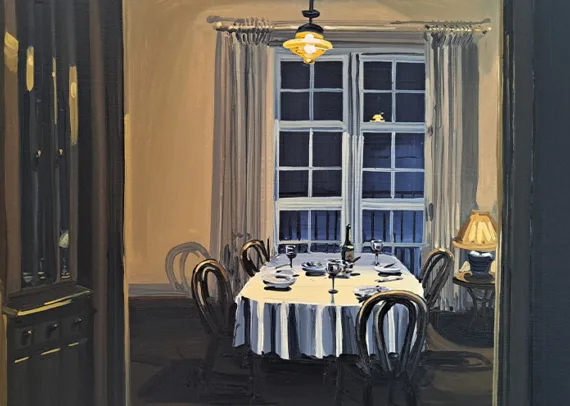-
 Apr 27 2013 - Jun 9 2013
Apr 27 2013 - Jun 9 2013
Places of this kind are outside of all places, even though it may be possible to indicate their location in reality 1
In the exhibition We Are Suddenly Somewhere Else O’Gorman invited the viewer to interact with a series of open-ended narratives related to place – or rather an experience of it.
Linking poetic, philosophical, historical or eyewitness account with contemporary site, O’Gorman made installations using a range of media from photographic or moving image, food to utilitarian materials such as silver or bone china. Occasionally slipping into the structure of a semi-fictional, museum-like display (using vinyl text, found object, reference documentation and plinth) those narratives act as indicators, highlighting the importance of the viewer’s individual and past experience in connection with the subject.
In addition to re-imagining existing work, O’Gorman created a new installation for the Butler Gallery based upon it’s future site – Evans' Home. The artist projected imagery of the gallery’s future site in its current state of dereliction. The accompanying soundscape denotes a human presence, still hanging in the air – along with the suggestion that something is about to happen. Originally an almshouse for ‘decayed servants’, the transitional spaces – thresholds, hallways and stairwells – of this 19th century building, itself in a state of transition, are revealed, allowing the audience a glimpse of the remnants of it’s recent history as a domestic asylum and a library store. Capturing strong traces of it’s former use as an institution, the installation prompted a recognition of the significance of this past for the present, including the role of the gallery as a potential catalyst for communicating alternative perspectives; for making the ‘private’ public.
In works entitled Neither Here Nor There and Sketches for Faraway Places O’Gorman explored another tangent where re-enactments and places (both physical and psychological) are imagined, described or reinterpreted. Drawing from historical documentation and account, the installation references local historian Edward J. Law’s research on William Grace – a 19th century character whose fate was connected with Evans Home. Using stereoscopic and double imagery of seascapes from varying perspectives, the work speculates upon duality, displacement and upon the simultaneous desire to be – or imposition of being – somewhere else.
Bridget O’Gorman graduated with a BA in Fine Art Painting from the Crawford College of Art in 2003. In 2008, she completed an MFA between the Department of Applied Art and The School of Sculpture at Edinburgh College of Art in Scotland. Her work has been supported through awards from The Crafts Council of Ireland, The Arts Council of Ireland, the Worshipful Company of Glass Sellers London, the Royal Scottish Academy, Edinburgh, The Bank of Ireland and Kilkenny County Council’s Arts Office. O’Gorman was the recipient of the 2010 Emerging Visual Artist Award from the Wexford Arts Centre where she also had a solo exhibition. Selected group exhibitions include Claremorris Open 2011 curated by Chris Hammond and ‘Re-set’ selected by Emma-Lucy O’Brien at VISUAL Centre for Contemporary Art, Carlow.
The artist would like to acknowledge the Cork Film Centre, the Artist-In-Residence programme at the National Sculpture Factory supported by Cork Arts Support Team, and the assistance of Fire Station Artists’ Studios through their Digital Media Award Sept-Dec 2012.
With grateful thanks to The Arts Council for essential annual funding and to the OPW, FÁS, The Heritage Council, and the Kilkenny Local Authorities for additional assistance.
[1] Of Other Spaces, Michel Foucault; Jay Miskowiec Diacritics, Vol. 16, No. 1. (Spring, 1986), pp. 22-27. French theorist Foucault on ‘the ever-accumulating past’ and what he coined as heterotopias (eg. museums, ships, mirrors etc)




 Opening Hours
Opening Hours